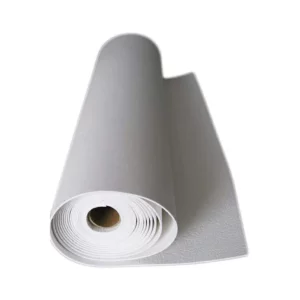The customization process of aluminum silicate ceramic fiber paper can have a significant impact on its density and porosity. The manufacturing and customization techniques employed play a crucial role in determining the final characteristics of the ceramic fiber paper.
Here’s how the customization process can influence density and porosity:
- Material Composition:
- The customization process begins with selecting the raw materials and their proportions. The type and amount of aluminum silicate fibers and binders used can directly affect the density and porosity of the ceramic fiber paper.
- Formulation and Mixing:
- During the formulation stage, various components, including fibers, binders, and additives, are mixed to create a homogeneous blend. The choice of additives and the mixing process can influence the porosity and density of the final product.
- Beating or Pulp Formation:
- In some manufacturing processes, the fiber mixture undergoes beating or pulping to create a pulp-like consistency. The degree of beating can impact the fiber distribution, which, in turn, affects the density and porosity of the ceramic fiber paper.
- Forming Process:
- The forming process involves depositing the fiber mixture onto a forming fabric or belt. The method of forming, such as wet or dry forming, can influence the packing density of fibers and the overall porosity of the sheet.
- Pressing and Compaction:
- Pressing is a common step to remove excess water and consolidate the fiber structure. The pressure applied during pressing affects the compaction of fibers, influencing both density and porosity. Higher pressure tends to increase density but may reduce porosity.
- Drying Conditions:
- The drying process is critical in setting the final structure of the ceramic fiber paper. The temperature and duration of drying can impact the removal of water, binder curing, and overall densification. China aluminium silicate ceramic fiber paper suppliers Careful control of drying conditions is essential for achieving the desired density and porosity.
- Binder Burnout and Firing:
- Binder burnout and firing processes are crucial for eliminating organic binders and achieving the final ceramic state. The firing temperature and duration impact sintering and crystallization, affecting the density and porosity of the ceramic fiber paper.
- Customization for Specific Applications:
- Manufacturers may customize the paper for specific applications by adjusting the formulation and processing parameters. For applications requiring high density and low porosity, the customization process may emphasize compaction and controlled firing.
- Addition of Fillers or Additives:
- Customization may involve incorporating fillers or additives to modify the properties of the ceramic fiber paper. These additions can influence both density and porosity, depending on their nature and concentration.
- Quality Control Measures:
- Quality control measures during the customization process ensure consistency in density and porosity across batches. Monitoring and adjusting processing parameters based on quality control results help maintain the desired characteristics.
In summary, the customization process of aluminum silicate ceramic fiber paper involves a series of steps that collectively determine its density and porosity. By carefully controlling material composition, processing conditions, and specific customization steps, manufacturers can tailor the paper to meet the requirements of various applications, achieving the desired balance between density and porosity.
